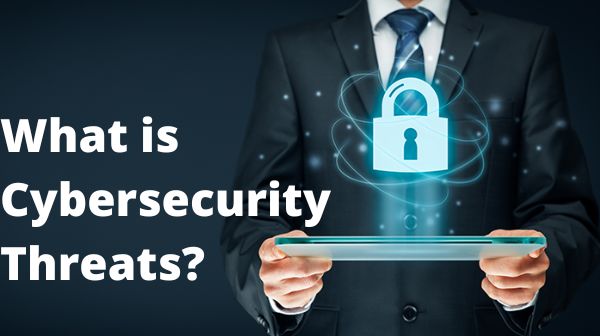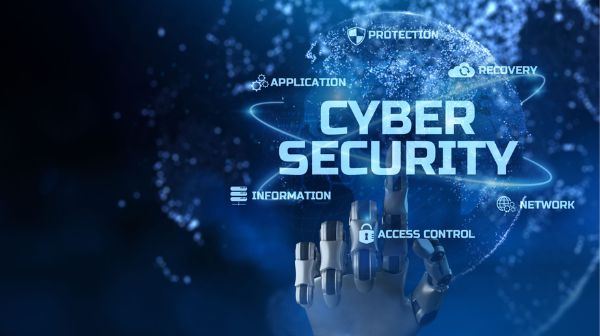What is Cybersecurity Threats?

Cybersecurity Threats- A malevolent act that aims to destroy data, steal data, or otherwise interfere with digital life is referred to as a cyber threat or cybersecurity threat. Computer viruses, data breaches, DoS assaults, and other attack methods are examples of cyber threats.
Cyber threats also refer to the chance of a case of cyber attack with the intent of stealing sensitive data, damaging or disrupting a computer network, or gaining unauthorized access to an information technology resource. Cyberthreats may originate from a company’s own trusted employees or may come from distant, unidentified parties.
What Sources Do Cybersecurity Threats Have?
There are several threat organizations that use cyber, including:-
Hostile Nation-States
New cyber dangers include propaganda, website vandalism, espionage, disruption of critical infrastructure, and even human casualties, according to national cyber warfare programs. When compared to other threat actors, government-sponsored programs are becoming more sophisticated as well as pose advanced dangers.
The national security of several nations, such as the United States, could suffer significant, long-term harm from their emerging capabilities. Due to its capability to use technology and techniques against the most challenging targets, such as classified systems as well as crucial infrastructure like electrical grids as well as gas control valves, hostile nation-states offer the greatest risk.
Terrorist Groups
Increasingly, terrorist organizations target national interests through cyberattacks. Compared to nation-states, they are less skilled in cyberattacks and less likely to use them. As more technologically savvy generations join their ranks, it is anticipated that terrorist organizations will pose significant cyber dangers.

Corporate Spies and Organized Crime Organizations
Due to their capacity for industrial espionage to steal trade secrets or massive financial thievery, corporate spies and organized criminal groups constitute a risk.
In most cases, these parties are motivated by profit-based activities, either making money or interfering with a company’s capacity to make money by assaulting competitors’ vital infrastructure, stealing trade secrets, or getting access to and using blackmail to obtain information.
Hacktivists
Political beliefs and causes are all covered by hacktivists’ activity. Instead of destroying infrastructure or interrupting services, the majority of hacktivist groups are more interested in disseminating misinformation. Instead of doing the most harm to an institution, their objective is to further their political agenda.
Disgruntled Insiders
A frequent source of cybercrime is disgruntled insiders. Because they may be allowed to view the data, insiders don’t always need a high level of computer competence to reveal sensitive material.
Third-party suppliers and staff members who may unintentionally inject malware into networks or who may log into the secure S3 bucket, extract its contents, as well as post them online in order to cause a data breach are also considered insider risks. S3 permissions must be checked, or else someone else will.
Hackers
A zero-day exploit could be used by malicious attackers to gain unauthorized access to data. Information systems may be breached by hackers as a challenge or for bragging rights. This used to need a lot of expertise. Today, sophisticated attacks are made simple by the availability of automated attack scripts as well as protocols on the Internet.
Natural Disasters
Natural disasters pose a cyber danger since they have the same potential to damage your vital infrastructure as a cyberattack.
Authorized Users’ Accidental Behavior
A potential data breach could result from an authorized user failing to configure S3 security properly. Instead of hackers or unhappy insiders, some of the worst data breaches have been the result of bad configuration.
What types of cyber threats are examples?
Common online threats include:
Malware
Malware is software that performs harmful operations on a computer system or network, such as corrupting data or seizing control of an entire network.
Spyware
Spyware is a type of malware that conceals itself on a device and shares real-time information with its host, allowing the host to steal information like bank account numbers and passwords.
Phishing Attacks
Phishing is when a cybercriminal tries to seduce a victim into revealing sensitive information, like passwords, banking as well as credit card info, as well as personally identifying information (PII). Passkeys and the passkey auth method can help prevent phishing attacks by simplifying the login process and removing the need for users to remember multiple passwords.
Distributed Denial of Service (DDoS) Attacks
In order to overburden the system and prevent legitimate requests from being fulfilled, distributed denial of service attacks bombard a computer network with unnecessary requests.
Ransomware
Malware known as ransomware prevents users from accessing a computer system or certain data unless a ransom is paid.
Zero-Day Exploits
A zero-day exploitation is a software, hardware, or firmware weakness that has not yet been patched by the responsible party or parties.
Advanced Persistent Threats
When an unauthorized user gains access to systems or networks as well as stays there for a long time without being discovered, that situation is known as an advanced persistent threat.
Trojans
Using a trojan, an attacker can access sensitive data or take control of your computer by opening a backdoor in your system.
Wiper Attacks
A malware assault known as a “wiper” aims to delete all data from the infected computer’s hard disc.
Intellectual property Theft
Theft of intellectual property is the taking or unauthorized use of another person’s intellectual property.
Financial Theft
Credit card or bank account details may be exposed during cyberattacks, allowing for the theft of money.
Data Manipulation
Data manipulation is a type of cyberattack that seeks to manipulate the data rather than steal it in order to make it more difficult for an organization to function.
Data Destruction
When a cyber attacker tries to remove data, that is considered data destruction.
Man-in-the-Middle Attack (MITM Attack)
When two parties that believe they are talking with each other are actually being attacked, the communication may be relayed and even altered.
Drive-by Downloads
Unintentional downloads, such as those that install malware, spyware, or computer viruses, are known as drive-by download attacks.
Malvertising
Malvertising is the practice of using web marketing to disseminate malware.
Rogue Software
Malware that passes for legitimate software is referred to as rogue software.
Unpatched Software
Software that has not been upgraded but has a known security problem that has been resolved in a future update is said to be unpatched.
Data Centre Disrupted by Natural Disaster
A natural calamity like flooding could impair the data center where your software is kept.
Top Cyber Threats for 2022
You should be aware of the following list of the most dangerous cyber threats in 2022.
Phishing attempts with a Covid theme
Victims are provided with seemingly innocent emails or webpages that are contaminated with harmful links during a phishing attempt. A process of credential theft is started when you interact with these links. When fear is a driving force behind interaction, these attacks are most successful.
Covid-themed phishing attacks have increased since the coronavirus outbreak, relying on the public’s fears about viruses.
Internal Threats
57 percent of all database breaches in 2019 contained insider threats, according to research. This kind of security-bypassing cyber threat cannot be handled using a control plan, unlike phishing attempts.
Access to sensitive resources should only be granted to people who truly need it in order to protect themselves from insider threats. To do this, Privileged Access Management (PAM) security is helpful.
Ransomware Attacks
One of the most terrifying online threats is ransomware assaults. The sensitive data of the victim is encrypted throughout these attacks, and it can only be unlocked when a ransom is paid. Victims are only made aware that they’ve been hacked when they receive a terrifying message confirming the attack’s success.
Files Polyglot
Multiple file type identities are possible with polyglot files. Some polyglot files, for instance, fall within the PPT and JS categories and can be read by programs that support both file formats.
There is no inherent hostility in polyglot files. To get around file-type security measures, cybercriminals package dangerous malware inside polyglot files. Some programmers restrict the file extensions that can be uploaded or opened. DOC, GIF, and JPEG files are frequently used here.
Why is Protection Against Cyber Threats Required?
Every firm faces cybersecurity hazards, which frequently escape the direct supervision of your IT security personnel.
A considerably wider attack vector than in the past is caused by rising worldwide connections, the use of cloud services, as well as outsourcing. In order to lower the risk of third-party data theft, third-party risk assessment, vendor risk management, and cyber risk strategic planning are becoming more and more crucial. Third-party risk and fourth-party risk are on the rise.
Add to that the fact that company executives routinely and covertly assess the risks associated with technology across all departments.
Consider that your CMO is testing a new email campaign tool. This could be a significant security risk that exposes your clients’ personally identifiable information (PII), leading to identity theft, or even anti-virus technology that uses inadequate security methods.
Information security must be a company-wide initiative, regardless of whether you operate in the public or private sector. It cannot be left to your Chief Information Security Officer (CISO).
Read Also-
- What is Cybersecurity? Everything You Need to Know
- Cybersecurity in 2023: Navigating the Digital Battlefield
- 5 secrets only cybersecurity pros and hackers know
How to Protect Against and Identify Cyber Threats?
Cyber threat intelligence exercises are useful places to start learning how to safeguard your firm from cyber threats.
After being gathered, considered, and analyzed, cyber threat information becomes cyber threat intelligence. Cyber threat information helps you better comprehend cyber risks and enables you to accurately and quickly spot the similarities and differences between various cyber threat types.
The intelligence cycle, a cyclical procedure, is used to create cyber threat intelligence. Data gathering is planned, carried out, and analyzed in the intelligence cycle to create a report, which is then distributed and updated in light of any new information.
Because you could find cybersecurity gaps, and unknowns, or be urged to gather new requirements and repeat the intelligence cycle throughout the collection or evaluation phase, the process is circular.
With an examination of their tactics, techniques, as well as procedures (TTPs), motivations, as well as access to primary destinations, analysis is centered on the triad of actors, intent, and capability.
Making informed strategic, operational, as well as tactical assessments is made feasible by examining the trio of actors:
Strategic Assessments
Strategic evaluations Decision-makers should be informed of big, long-term concerns while also receiving prompt alerts to potential dangers. Strategic cyber threat intelligence creates a picture of the motivations, tools, and potential risks posed by malevolent cyber attackers.
Operational Assessments
Operational assessments identify probable occurrences connected to events, inquiries, or actions and offer instructions on how to handle them. For instance, what to do if malware has been installed on a computer.
Tactical Assessments
Daily support is provided through tactical assessments, which are in-the-moment evaluations of events, investigations, and actions.
A speedier, more focused response is encouraged by properly used cyber threat intelligence, which offers insights into cyber dangers. It can support incident response and post-incident response operations and help decision-makers identify acceptable cybersecurity risks, controls, as well as financial restrictions for staffing and equipment.
Frequently Asked Questions (FAQs)
1. Are cyberattacks more frequent and sophisticated?
Yes. Unfortunately, cyberattacks are becoming increasingly common and complex. Hackers are constantly innovating, utilizing advanced techniques like social engineering, zero-day exploits, and supply chain attacks to infiltrate systems and steal data. The rise of connected devices and remote work environments further expands the attack surface, making organizations more vulnerable.
2. What are the top cybersecurity threats of 2024?
Several key threats dominate the cybersecurity landscape today:
Ransomware: This malware encrypts critical data, holding it hostage until a ransom is paid. The sophistication of ransomware attacks is growing, and they now target not just businesses but also individuals and vital infrastructure.
Supply Chain Attacks: Hackers infiltrate third-party vendors or software suppliers to gain access to target systems further down the line. These attacks are challenging to detect and mitigate due to their indirect nature.
Phishing and Social Engineering: These tactics manipulate users into clicking malicious links, opening infected attachments, or divulging sensitive information. They remain successful as hackers refine their techniques to exploit human vulnerabilities.
Deepfakes and Disinformation: AI-generated fake videos and audio recordings can be used to spread misinformation, damage reputations, and manipulate public opinion. This threat continues to evolve, posing new challenges for verification and trust online.
Internet of Things (IoT) Vulnerabilities: The explosion of connected devices introduces new attack vectors. Exploiting insecure IoT devices can provide hackers with access to personal data, smart homes, and even critical infrastructure.
3. How can individuals protect themselves online?
Practice strong password hygiene: Use unique, complex passwords and enable multi-factor authentication whenever possible.
Beware of phishing attempts: Think before clicking on links or opening attachments, and verify the sender’s identity.
Update software regularly: Patching vulnerabilities promptly is crucial to stay ahead of known threats.
Be cautious about what you share online: Limit personal information shared on public platforms and be mindful of privacy settings.
Use a reputable security software: Employ antivirus, anti-malware, and firewall protection to safeguard your devices.
Stay informed: Keep up with the latest cybersecurity threats and trends to adapt your defenses accordingly.
4. What steps can businesses take to improve their cybersecurity posture?
Conduct regular security assessments: Identify and address vulnerabilities in your systems and networks.
Implement robust security controls: Utilize firewalls, intrusion detection systems, and data encryption to protect sensitive information.
Invest in employee training: Equip your workforce with the knowledge and skills to recognize and avoid cyber threats.
Have a data breach response plan: Prepare for potential incidents to minimize damage and recover quickly.
Stay updated on evolving regulations: Ensure compliance with relevant data privacy and security laws.
5. Is cybersecurity a shared responsibility?
Absolutely. Individuals, businesses, and governments all play a critical role in maintaining a secure online environment. Individual vigilance can prevent many attacks, while businesses need to prioritize cybersecurity investments and best practices. Collaboration between public and private entities is essential for sharing threat intelligence, developing defensive strategies, and holding cybercriminals accountable.
6. What are the future trends in cybersecurity?
Artificial intelligence (AI) will play a more prominent role: Both attackers and defenders will leverage AI for more sophisticated tactics and advanced threat detection.
Focus on cloud security will be paramount: As cloud adoption increases, securing cloud environments will be critical.
Cybercrime-as-a-service (CaaS) will continue to grow: The barrier to entry for cybercrime will lower, requiring increased vigilance.
Quantum computing poses potential risks and opportunities: This emerging technology could render current encryption methods obsolete, necessitating new security solutions.
7. What is the outlook for the future of cybersecurity?
The cybersecurity landscape is dynamic and continuously evolving. New threats will emerge, and staying ahead of them requires constant vigilance and adaptation. By proactively adopting best practices, individuals and businesses can significantly improve their resilience against cyberattacks, fostering a more secure digital future for all.






